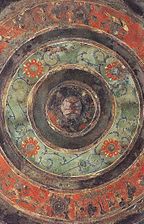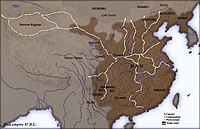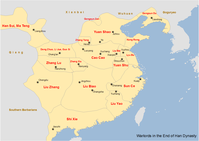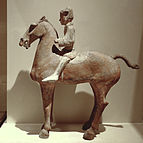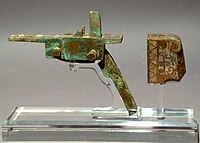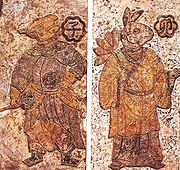Han dynasty
The "Scots" that wis uised in this airticle wis written bi a body that haesna a guid grip on the leid. Pleasemak this airticle mair bettergin ye can.(Januar 2021) |
Han dynasty Hán triều | |||||||||||
|---|---|---|---|---|---|---|---|---|---|---|---|
| 206 BC–220 AD | |||||||||||
![A cairt o the Wastren Han Dynasty in 2 AD: 1) the territory shadit in dark blue represents the principalities andcentrally-admeenistered commanderies o the Han Empire; 2) the licht blue aurie shaws the extent o the Tarim Basin pertectorate o the Wastren Regions.[1]](https://upload.wikimedia.org/wikipedia/commons/thumb/f/f9/Han_Dynasty_Plain_map.PNG/250px-Han_Dynasty_Plain_map.PNG) A cairt o the Wastren Han Dynasty in 2 AD: 1) the territory shadit in dark blue represents the principalities andcentrally-admeenisteredcommanderieso the Han Empire; 2) the licht blue aurie shaws the extent o theTarim Basinpertectorate o theWastren Regions.[1] | |||||||||||
| Status | Empire | ||||||||||
| Caipital | Chang'an (206 BC – 9 AD, 190–195 AD) Luoyang (25–190 AD, 196 AD) Xuchang (196–220 AD) | ||||||||||
| Common leids | Auld Cheenese | ||||||||||
| Releegion | Taoism,Confucianism,Cheenese folk releegion | ||||||||||
| Govrenment | Monarchy | ||||||||||
| Emperor | |||||||||||
• 202–195 BC | Emperor Gaozu | ||||||||||
• 25–57 AD | Emperor Guangwu | ||||||||||
| Chancellor | |||||||||||
• 206–193 BC | Xiao He | ||||||||||
• 193–190 BC | Cao Can | ||||||||||
• 189–192 AD | Dong Zhuo | ||||||||||
• 208–220 AD | Cao Cao | ||||||||||
• 220 AD | Cao Pi | ||||||||||
| History | |||||||||||
• Establishment | 206 BC | ||||||||||
•Battle o Gaixia;Han rule o Cheenae begins | 202 BC | ||||||||||
| 9–23 | |||||||||||
• Abdication taeCao Wei | 220 AD | ||||||||||
| Aurie | |||||||||||
| 50 BC est.[2] | 6,000,000 km2(2,300,000 sq mi) | ||||||||||
| Population | |||||||||||
• 2 AD[3] | 57,671,400 | ||||||||||
| Currency | Ban liang coinsanwu zhu coins | ||||||||||
| |||||||||||
| The day pairt o | |||||||||||
TheHan dynasty(simplifeed Cheenese:Hán triều;traditeeonal Cheenese:Hán triều;pinyin:Hàn Cháo;Wade–Giles:Han Ch'ao;IPA:[xân tʂʰɑ̌ʊ̯]) wis the seicontimperial dynasty o Cheenae,precedit bi theQin dynasty(221–207 BC) an succeedit bi theThree Kinricksperiod (220–280 AD). Spannin ower fower centuries, the Han period is conseedert agowden agein Cheenese history.[4]Tae this day, Cheenae'smajority ethnic grouprefers tae themsels as the "Han Cheenese" an the Cheenese script is referred tae as "Han chairacters".[5]It wis foondit bi the rebel leaderLiu Bang,kent posthumouslyasEmperor Gaozu o Han,an briefly interruptit bi theXin dynasty(9–23 AD) o the umwhile regentWang Mang.This interregnum separates the Han dynasty intae twa periods: theWastren Hanor Umwhile Han (206 BC – 9 AD) an theEastren Hanor Later Han (25–220 AD).
The emperorwis at the pinnacle oHan society.He presidit ower theHan govrenmentbut shared pouer wi baiththe nobilityan appyntit meenisters that cam lairgely frae the scholarlygentry cless.The Han Empire wis dividit intae auries directly controlled bi the central govrenment uisin an innovation inheritit frae the Qin kent ascommanderies,an a nummer osemi-autonomous kinricks.Thir kinricks gradually lost aw vestiges o thair unthirldom, pairteecularly follaein theRebellion o the Seiven States.Frae the ring oEmperor Wu(r. 141–87 BC) onwart, the Cheenese coort offeecially sponsoredConfucianismin eddication an coort politics, synthesised wi thecosmologyo later scholarts sic asDong Zhongshu.This policy endured till the faw o theQing dynastyin 1911 AD.
The Han dynasty saw anage o economic prosperityan witnessed a signrrficant growthe o themoney economyfirst established in theZhou dynasty(c. 1050–256 BC).The coinageissued bi the central govrenmentmintin 119 BC remeened the staundart coinage o Cheenae till theTang dynasty(618–907 AD). The period saw a nummer o leemitit institutional innovations. Taefinance its militar campaignsan the dounset o newly conquered frontier territories, the Han govrenmentnaitionalisedthe preevat saut an airn industries in 117 BC, but thir govrenment monopolies war repealed in the Eastren Han dynasty.Science an technology in the Han periodsaw signeeficant advances, includin the process opapermakin,the nautical steerin shiprither,the uise onegative nummersinmathematics,theraised-relief map,thehydraulic-poueredarmillary sphereforastronomy,an aseismometeremployin aninvertit pendulumthat coud be uised tae discern the cardinal direction o distant yirdquauks.
TheXiongnu,a nomadicsteppeconfederation,[6]defeatit the Han in 200 BC an forced the Han tae submit as ade factoinferior an vassal pairtner, but conteena'd thair militar raids on the Han mairches. Emperor Wu launchedseveral militar campaignsagainst them. The ultimate Han veectory in thir wars eventually forced the Xiongnu tae accept vassal status asHan tributaries.Thir campaigns expandit Han sovereignty intae theTarim BasinoCentral Asie,dividit the Xiongnu intae twa separate confederations, an helped establish the vast tred netwark kent as theSilk Road,that reached as faur as theMediterranean warld.The territories north o Han's mairches war quickly owerrun bi the nomadicXianbeiconfederation. Emperor Wu launched successfumilitar expedeetions in the soothforby, annexinNanyue in 111 BCanDian in 109 BC,an in theKorean Peninsulawhaur theXuantuanLelang Commanderieswar established in 108 BC. Efter 92 AD, the pailaceeunuchsincreasinly involved themsels in coort politics, engagin in veeolent pouer struggles atween the variousconsort clanso the empresses anempresses dowager,causin the Han's ultimate dounfaw. Imperial authority wis seriously challenged bi lairgeDaoistreleegious societies that instigatit theYellae Turban Rebellionan theFive Pecks o Rice Rebellionforby. Follaein the daith oEmperor Ling(r. 168–189 AD), the pailace eunuchssuffered wholesale massacrebimilitar officers,allouin members o the aristocracy an militar govrenors tae acome warlairds andivide the empire.WhanCao Pi,King oWei,usurped the throne fraeEmperor Xian,the Han dynasty ceased tae exeest.
History
[eedit|eedit soorce]Wastren Han
[eedit|eedit soorce]Richt eemage:Reverse side o a Wastren-Hanbronze mirrorwith painted designs of a flower motif
Cheenae's firstimperial dynastywis theQin dynasty(221–207 BC). The Qin unifee'd the CheeneseWarrin Statesbi conquest, but thair empire becam unstable efter the daith o the first emperorQin Shi Huang.Within fower years, the dynasty's authority haed collapsed in the face o rebellion.[7]Twa umwhile rebel leaders,Xiang Yu(d. 202 BC) oChuanLiu Bang(d. 195 BC) oHan,engagedin a wartae decide that wad acome hegemon o Cheenae, that haed fissured intae18 kinricks,each claimin allegiance tae aither Xiang Yu or Liu Bang.[8]Awtho Xiang Yu pruived tae be a capable commander, Liu Bang defeatit him atBattle o Gaixia(202 BC), in modren-dayAnhui.Liu Bang assumed the teetle"emperor"(huangdi) at the urgin o his follaers an is kent posthumously asEmperor Gaozu(r. 202–195 BC).[9]Chang'an(kent the day as Xi'an) wis chosen as the new caipital of the reunified empire unner Han.[10]
At the beginnin o theWastren Han(traditeeonal Cheenese:Tây Hán;simplifeed Cheenese:Tây Hán;pinyin:Xīhàn), kent as theUmwhile Han(traditeeonal Cheenese:Tây Hán;simplifeed Cheenese:Tây Hán;pinyin:Qiánhàn) dynasty forby, thirteen centrally controlledcommanderies—includin the caipital region—existit in the wastren third o the empire, while the eastren twa-thirds war dividit intae tensemi-autonomous kinricks.[11]Tae placate his prominent commanders frae the war wi Chu, Emperor Gaozuenfeoffedsome o them as kings. Bi 157 BC, the Han coort haed replaced aw o thir kings wi ryalLiufaimily members, syne the lealty o non-relatives tae the throne wis quaistened.[11]Efter several insurrections bi Han kings—the lairgest bein theRebellion o the Seiven Statesin 154 BC—the imperial coort enactit a series o reforms beginnin in 145 BC leemitin the size an pouer o thir kinricks an dividin thair umwhile territories intae new centrally controlled commanderies.[12]Kings war na langer able tae appynt thair ain staff; this duty wis assumed bi the imperial coort.[13]Kings becam nominal heads of thairfiefsan collectit a portion of tax revenues as thair personal incomes.[13]The kinricks war niver entirely abolished an existit ootthrou the remeender o Wastren an Eastren Han.[14]

Tae the north oCheenae proper,the nomadicXiongnuchieftainModu Chanyu(r. 209–174 BC) conquered various tribes inhabitin the eastren portion o theEurasian Steppe.Bi the end o his ring, he controlledManchurie,Mongolie,an theTarim Basin,subjugatin ower twinty states east oSamarkand.[16]Emperor Gaozu wis tribbled aboot the abundant Han-manufactured airn wappens treddit tae the Xiongnu alang the northren mairches, an he established a tredembargoagainst the group.[17]In retaliation, the Xiongnu invadit whit is nouShanxiprovince, whaur thaydefeat the Han forces at Baidengin 200 BC.[18]Efter negotiations, theheqingreement in 198 BC nominally held the leaders o the Xiongnu an the Han as equal partners in a royal marriage alliance, but the Han war forced tae send muckle amunts o treebute eetems sic assilkenclaes, fuid, an wine tae the Xiongnu.[19]

Despite the treebute an a negotiation atweenLaoshang Chanyu(r. 174–160 BC) anEmperor Wen(r. 180–157 BC) tae reappen mairch mercats, mony o theChanyu's Xiongnu subordinates chuise nae tae obey the treaty an periodically raidit Han territories sooth o theGreat Wawfor addeetional guids.[21]In a coort conference assembled biEmperor Wu(r. 141–87 BC) in 135 BC, themajority consensuso the meenisters wis tae retain theheqingreement. Emperor Wu acceptit this, despite conteenuin Xiongnu raids.[22]Houiver, a coort conference the follaein year convinced the majority that aleemitit engagement at Mayiinvolvin the assassination o the Chanyu wad thraw the Xiongnu realm intae chaos an benefit the Han.[23]Whan this plot failed in 133 BC,[24]Emperor Wu launched a series omassive militar invasionsintae Xiongnu territory. The assaut culminatit in 119 BC at theBattle o Mobei,whaur the Han commandersHuo Qubing(d. 117 BC) anWei Qing(d. 106 BC) forced the Xiongnu coort tae flee north o theGobi Desert.[25]
Efter Wu's reign, Han forces conteena'd tae prevail against the Xiongnu. The Xiongnu leader Huhanye Chanyu ( Hô Hàn Tà ) (r. 58–31 BC) feenally submittit tae Han as a tributar vassal in 51 BC. His rival claimant tae the throne,Zhizhi Chanyu(r. 56–36 BC), wis killt biChen Tangan Gan Yanshou ( cam duyên thọ / cam duyên thọ ) at theBattle o Zhizhi,in modrenTaraz,Kazakhstan.[26]
In 121 BC, Han forces expelled the Xiongnu frae a vast territory spannin theHexi CorridortaeLop Nur.Thay repelled a jynt Xiongnu-Qianginvasion o this northwastren territory in 111 BC. In that year, the Han coort established fower new frontier commanderies in this region:Jiuquan,Zhangyi,Dunhuang,anWuwei.[27]The majority o fowk on the frontier war sodgers.[28]On occasion, the coort forcibly muived paisant farmers tae new frontier settlements, alang wi govrenment-awned sclaves an convicts that performed haurd laubour.[29]The coort encouragedcommoners,sic as fermers, merchands, laundawners, an hired laubourers, tae voluntarily migrate tae the mairches forby.[30]
Even afore Han's expansion intae Central Asie, diplomatZhang Qian's traivels frae 139 tae 125 BC haed established Cheenese contacts wi mony surroondin ceevilisations. Zhang encoonteredDayuan(Fergana),Kangju(Sogdiana), anDaxia(Bactrie,umwhile theGreco-Bactrian Kinrick); he gaithert information on Shendu (Indus Rivervalley oNorth Indie) an Anxi (theParthian Empire) forby. Aw o thir kintras eventually received Han embassies.[31]Thir connections merked the beginnin o theSilk Roadtrede netwark that extendit tae theRoman Empire,bringinHan eetems lik silktae Roum anRoman guids sic as glesswarestae Cheenae.[32]
Frae rochly 115 tae 60 BC, Han forces focht the Xiongnu ower control o the oasisceity-statesin the Tarim Basin. Han wis eventually veectorious an established thePertectorate o the Wastren Regionsin 60 BC, that dealt wi the region's defence an furrin affairs.[33]The Hanexpandit soothwartforby. Thenaval conquest o Nanyuein 111 BC expandit the Han realm intae whit are nou modrenGuangdong,Guangxi,annorthren Vietnam.Yunnanwis brocht intae the Han realm wi theconquesto theDian Kinrickin 109 BC, follaed bi pairts o theKorean Peninsulawi theHan conquest o Gojoseonan colonial establishments oXuantu CommanderyanLelang Commanderyin 108 BC.[34]In Cheenae's first kent nationwidecensustaken in 2 AD, the population wis registered as haein 57,671,400 individuals in 12,366,470 households.[35]
Tae pey for his militar campaigns an colonial expansion, Emperor Wunaitionalisedseveral preevat industries. He creatit central govrenmentmonopoliesadmeenistered lairgely biumwhile merchants.Thir monopolies includit saut,airn,anliquorproduction, as weel asbronze-cunyie currency.The liquor monopoly lastit anly frae 98 tae 81 BC, an the saut an airn monopolies war eventually abolished in early Eastren Han. The issuin o coinage remeened a central govrenment monopoly ootthrou the rest o the Han dynasty.[36]The govrenment monopolies war eventually repealed whan a poleetical faction kent as the Reformists gained greater influence in the coort. The Reformists opponed the Modrenist faction that haed dominatit coort politics in Emperor Wu's ring an in the subsequentregencyoHuo Guang(d. 68 BC). The Modrenists airgie'd for an aggressive an expansionary furrin policy supportit bi revenues frae hivy govrenment intervention in the preevat economy. The Reformists, houiver, owerturned thir policies, favourin a cautious, non-expansionary approach tae furrin policy, frugalbudgetreform, an lawer tax-rates imponed on preevat entrepreneurs.[37]
Wang Mang's reign an ceevil war
[eedit|eedit soorce]Wang Zhengjun(71 BC–13 AD) wis first empress, thenempress dowager,an feenallygrand empress dowagerin the rings o the EmperorsYuan(r. 49–33 BC),Cheng(r. 33–7 BC), anAi(r. 7–1 BC), respectively. In this time, a succession o her male relatives held the teetle o regent.[38]Follaein the daith o Ai, Wang Zhengjun's neffaeWang Mang(45 BC–23 AD) wis appyntit regent as Marshall o State on 16 August unnerEmperor Ping(r. 1 BC–6 AD).[39]Whan Ping dee'd on 3 Februar 6 AD,Ruzi Ying(d. 25 AD) wis chuisen as the heir an Wang Mang wis appyntit tae serve as actin emperor for the bairn.[39]Wang promised tae relinquish his control tae Liu Ying ance he came of age.[39]Despite this promise, an against protest an revolts frae the nobility, Wang Mang claimed on 10 Januar that the divineMandate o Heivencried for the end o the Han dynasty an the beginnin o his ain: theXin dynasty(9–23 AD).[40]
Wang Mang ineetiatit a series o major reforms that war ultimately unsuccessfu. Thir reforms includitootlawin sclavery,naitionalisinlaund taeequally distributeatween hoosehauds, an introducin new sillers, a chynge that debased the vailyie o coinage.[41]Awtho thir reforms provoked conseederable opposeetion, Wang's regime met its ultimate dounfaw wi the massive fluids o c. 3 AD an 11 AD. Gradual silt bigup in theYellae Riverhaed raised its watter level an owerwhelmed thefluid control warks.The Yellae River split intae twa new brainches: ane emptiein tae the north an the ither tae the sooth o theShandong Peninsula,tho Han ingineers managed tae dam the soothren branch bi 70 AD.[42]
The fluid dislodged thoosands o paisant fermers, mony o whom jynt rovin bandit an rebel groups sic as theReid Eebroustae survive.[42]Wang Mang's airmies war incapable o quellin thir enlairged rebel groups. Eventually, an insurgent mob forced thair wey intae theWeiyang Pailacean killt Wang Mang.[43]
TheGengshi Emperor(r. 23–25 AD), a descendant oEmperor Jing(r. 157–141 BC), attemptit tae restore the Han dynasty an occupied Chang'an as his caipital. Houiver, he wis owerwhelmed bi the Reid Eebrou rebels that deponed, assassinatit, an replaced him wi the puppet monarchLiu Penzi.[44]Gengshi's distant cousin Liu Xiu, kent posthumously asEmperor Guangwu(r. 25–57 AD), efter distinguishin himsel at theBattle o Kunyangin 23 AD, wis urged tae succeed Gengshi as emperor.[45]
Unner Guangwu's rule the Han Empire wis restored. Guangwu madeLuoyanghis caipital in 25 AD, an bi 27 AD his officersDeng YuanFeng Yihaed forced the Reid Eebrous tae surrender an executit thair leaders fortraison.[46]Frae 26 till 36 AD, Emperor Guangwu haed tae wage war against ither regional warlairds that claimed the teetle o emperor; whan thir warlords war defeatit, Cheenae reunifee'd unner the Han.[47]
The period atween the foondation o the Han dynasty an Wang Mang's reign is kent as the Wastren Han (traditeeonal Cheenese:Tây Hán;simplifeed Cheenese:Tây Hán;pinyin:Xīhàn) or Former Han (traditeeonal Cheenese:Tây Hán;simplifeed Cheenese:Tây Hán;pinyin:Qiánhàn) (206 BC–9 AD). During this period the caipital wis atChang'an(modrenXi'an). Frae the ring o Guangwu the caipital wis moved eastward tae Luoyang. The era frae his reign tillthe faw o Hanis kent as the Eastern Han or Later Han (25–220 AD).[48]
Eastren Han
[eedit|eedit soorce]

TheEastren Han(traditeeonal Cheenese:Đông Hán;simplifeed Cheenese:Đông Hán;pinyin:Dōnghàn), kent as theLater Han(traditeeonal Cheenese:Đông Hán;simplifeed Cheenese:Đông Hán;pinyin:Hòuhàn) forby, formally begoud on 5 August 25, whan Liu Xiu becamEmperor Guangwu o Han.[49]In the widespreid rebellion against Wang Mang, the state oGoguryeowis free tae raid Han'sKorean commanderies;Han did nae reaffirm its control ower the region till AD 30.[50]TheTrưng SistersoVietnamrebelled against Han in AD 40. Thair rebellion wis crushed bi Han generalMa Yuan(d. AD 49) in a campaign frae AD 42–43.[51]Wang Mang renewed hostilities against theXiongnu,that war estranged frae Han till thair leader Bi ( so ), a rival claimant tae the throne against his cuisin Punu ( bồ nô ), submitted tae Han as a tributar vassal in AD 50. This creatit twa rival Xiongnu states: the Soothren Xiongnu led bi Bi, an ally o Han, an the Northren Xiongnu led bi Punu, an enemy o Han.[52]
In the turbulent ring o Wang Mang, Cheenae lost control ower the Tarim Basin, that wis conquered bi the Northren Xiongnu in AD 63 an uised as a base tae invade the Hexi Corridor inGansu.[53]Dou Gu(d. 88 AD) defeatit the Northren Xiongnu at theBattle o Yiwuluin AD 73, evictin them fraeTurpanan chasin them as faur asLoch Barkolafore establishin a garrisonat Hami.[54]Efter the new Pertector General o the Wastren RegionsChen Mu(d. AD 75) wis killt bi allies o the Xiongnu inKarasahranKucha,the garrison at Hami wis widrawn.[55]At theBattle o Ikh Bayanin AD 89,Dou Xian(d. AD 92) defeatit theNorthren Xiongnu chanyuthat then retreatit intae theAltai Muntains.[56]Efter the Northren Xiongnu fled intae theIli Rivervalley in AD 91, the nomadicXianbeioccupied the aurie frae the mairches o theBuyeo Kinrickin Manchurie tae the Ili River o theWusunfowk.[57]The Xianbei reached thair apogee unner Tanshihuai ( đàn thạch hòe ) (d. AD 180), that consistently defeatit Cheenese airmies. Houiver, Tanshihuai's confederation disintegratit efter his daith.[58]
Ban Chao(d. AD 102) enleetit the aid o theKushan Empire,occupyin the aurie o modrenIndie,Pakistan,Afghanistan,anTajikistan,tae subdueKashgaran its ally Sogdiana.[59]Whan a request bi Kushan rulerVima Kadphises(r. c. 90–c. 100 AD) for a mairiage alliance wi the Han wis rejectit in AD 90, he sent his forces taeWakhan(Afghanistan) tae attack Ban Chao. The conflict endit wi the Kushans widrawin acause o lack o supplees.[59]In AD 91, the office o Pertector General o the Wastren Regions wis reinstated whan it wis bestawed on Ban Chao.[60]

Furrin traivellers tae Eastren-Han Cheenae includeBuddhist monksthattranslatit warks intae Cheenese,sic asAn Shigaofrae Parthie, anLokaksemafrae Kushan-eraGandhara,Indie.[62]In addeetion tae tributar relations wi the Kushans, the Han Empire received gifts frae theParthian Empire,frae a king in modrenBurma,frae a rulerin Japan,an ineetiatit an unsuccessfu mission taeDaqin(Roum) in AD 97 wiGan Yingas emissar.[63]ARoman embassyo EmperorMarcus Aurelius(r. 161–180 AD) is recordit in theWeilüeanHou Hanshutae hae reached the coort oEmperor Huan o Han(r. AD 146–168) in AD 166,[64][65]yetRafe de Crespignyasserts that this wis maist likely a group oRoman merchands.[66]In addeetion taeRoman glesswaresancunyiesfoond in Cheenae,[67]Romanmedallionsfrae the ring oAntoninus Piusan his adoptit son Marcus Aurelius hae been foond atÓc Eoin Vietnam.[68]This wis near the commandery oRinan(Jiaozhiforby) whaur Cheenese soorces claim the Romans first laundit, as weel as embassies fraeTianzhu(in northren Indie) in the years 159 an 161.[69]Óc Eo is thocht tae be the port ceity "Cattigara"descrived biPtolemyin hisGeografie(c. 150 AD) as lyin east o theGowden Chersonese(Malay Peninsula) alang theMagnus Sinus(i.e.Gulf o ThailandanSooth Cheenae Sea), whaura Greek sailorhaed veesitit.[70]

Emperor Zhang's(r. 75–88 AD) ring came tae be viewed bi later Eastren Han scholars as the heich pynt o the dynastic hoose.[71]Subsequent rings war increasinly merked bieunuchintervention in coort politics an thair involvement in the veeolent pouer struggles o the imperialconsort clans.[72]Wi the aid o the eunuchZheng Zhong(d. 107 AD),Emperor He(r. 88–105 AD) haedEmpress Dowager Dou(d. 97 AD) put unnerhoose arrestan her clan stripped o pouer. This wis in revenge for Dou's purgin o the clan o his naitural mither—Consort Liang—an then concealin her identity frae him.[73]Efter Emperor He's daith, his wifeEmpress Deng Sui(d. 121 AD) managed state affairs as the regent empress dowager in a turbulent financial creesis an widespreid Qiang rebellion that lastit frae 107 tae 118 AD.[74]
Whan Empress Dowager Deng dee'd,Emperor An(r. 106–125 AD) wis convinced bi the accusations o the eunuchs Li Run (Lý nhuận) an Jiang Jing (Giang kinh) that Deng an her faimily haed planned tae depone him. An dismissed Deng's clan members frae office, exiled them an forced mony tae commit suicide.[75]Efter An's daith, his wife,Empress Dowager Yan(d. 126 AD) placed the bairnMarquess o Beixiangon the throne in an attempt tae retain pouer within her faimily. Houiver, pailace eunuchSun Cheng(d. 132 AD) mastermyndit a successfu owerthraw o her regime tae enthroneEmperor Shun o Han(r. 125–144 AD). Yan wis placed unner hoose arrest, her relatives war aither killt or exiled, an her eunuch allies war slauchtert.[76]The regentLiang Ji(d. 159 AD), brither oEmpress Liang Na(d. 150 AD), haed the brither-in-law oConsort Deng Mengnü(later empress) (d. 165 AD) killed efter Deng Mengnü resistit Liang Ji's attempts tae control her. Efterwart, Emperor Huan employed eunuchs tae depone Liang Ji, who wis then forced tae commit suicide.[77]

Students frae theImperial Varsityorganised a widespreadstudent protestagainst the eunuchs o Emperor Huan's coort.[79]Huan faur alienatit the bureaucracy whan he ineetiatit grandiose construction projects an hostit thoosands oconcubinesin hisharemat a time o economic creesis.[80]Pailace eunuchs impreesoned the offeecial Li Ying (Lý ưng) an his associates frae the Imperial Varsity on a dubious chairge o traison. In 167 AD, the Grand CommandantDou Wu(d. 168 AD) convinced his son-in-law, Emperor Huan, tae release them.[81]Houiver the emperor permanently baured Li Ying an his associates frae servin in office, merkin the beginnin o thePairtisan Prohibeetions.[81]
Follaein Huan's daith, Dou Wu an the Grand Tutor Chen Fan (Trần phiên) (d. 168 AD) attemptit acoup d'étatagainst the eunuchsHou Lan(d. 172 AD),Cao Jie(d. 181 AD), an Wang Fu (Vương phủ). When the plot wis unkivert, the eunuchs arrestitEmpress Dowager Dou(d. 172 AD) an Chen Fan. General Zhang Huan (Trương hoán) favourt the eunuchs. He an his truips confrontit Dou Wu an his reteeners at the pailace gate whaur ilk side shootit accusations o traison against the ither. Whan the reteeners gradually desertit Dou Wu, he wis forced tae commit suicide.[82]
UnnerEmperor Ling(r. 168–189 AD) the eunuchs haed the pairtisan prohibeetions renewed an expandit, while auctionin aff tap govrenment offices forby.[83]Mony affairs o state war entrusted tae the eunuchsZhao Zhong(d. 189 AD) anZhang Rang(d. 189 AD) while Emperor Ling spent muckle o his timeroleplayinwi concubines an pairteecipatin in militar parades.[84]
End o the Han dynasty
[eedit|eedit soorce]The Pairtisan Prohibeetions war repealed in theYellae Turban RebellionanFive Pecks o Rice Rebellionin 184 AD, lairgely acause the court did nae want tae continue tae alienate a signeeficant portion o thegentry clessthat micht otherwise jyne the rebellions.[85]The Yellae Turbans an Five-Pecks-o-Rice adherents belanged tae twa different hierarchicalDaoistreleegious societies led bifaith healersZhang Jue(d. 184 AD) anZhang Lu(d. 216 AD), respectively. Zhang Lu's rebellion, in modren northernSichuanan soothrenShaanxi,wis nae quelled till 215 AD.[86]Zhang Jue's massive rebellion across aichtprovinceswis annihilatit bi Han forces within a year, houiver the follaein decades saw muckle smawer recurrent uprisins.[87]Awtho the Yellae Turbans war defeatit, mony generals appyntit in the creesis niver disbaundit thair assemmledmilitiaforces an uised thir truips tae amass pouer ootside o the collapsin imperial authority.[88]
General-in-ChiefHe Jin(d. 189 AD), hauf-brither taeEmpress He(d. 189 AD), plottit wiYuan Shao(d. 202 AD) tae owerthraw the eunuchs bi haein several generals mairch tae the ootskirts o the caipital. Thare, in a written peteetion tae Empress He, thay demandit the eunuchs' execution.[89]Efter a period o hesitation, Empress He consentit. Whan the eunuchs diskivert this, houiver, thay haed her brither He Miao (Gì mầm) rescind the order.[90]The eunuchs assassinatit He Jin on 22 September 189 AD. Yuan Shao then besieged Luoyang's Northren Pailace while his britherYuan Shu(d. 199 AD) besieged the Soothren Pailace. On 25 September baith pailaces war breached an approximately twa thoosand eunuchs war killt.[91]Zhang Rang haed previously fled wiEmperor Shao(r. 189 AD) an his brither Liu Xie—the futurEmperor Xian o Han(r. 189–220 AD). While bein pursued bi the Yuan brithers, Zhang committit suicide bi jimpin intae the Yellae River.[92]
Richt:Detail o a mural shawin twa weemen weirinHanfusilkrobes,frae the Dahuting Tomb(Đánh hổ đình hán mộ;Dáhǔtíng hànmù) o the lateEastren Han Dynasty(25–220 AD), locatit inZhengzhou,Henan
GeneralDong Zhuo(d. 192 AD) foond the young emperor an his brither wanderin in the kintraside. He escortit them saufly back tae the caipital an wis madeMeenister o Warks,takkin control o Luoyang an forcin Yuan Shao tae flee.[94]Efter Dong Zhuo demotit Emperor Shao an promotit his brither Liu Xie as Emperor Xian, Yuan Shao led a coaleetion o umwhile offeecials an officers against Dong, that borned Luoyang tae the grund an resettled the coort at Chang'an in Mey 191 AD. Dong Zhuo later pushioned Emperor Shao.[95]
Dong wis killt bi his adoptit sonLü Bu(d. 198 AD) in a plot hatched biWang Yun(d. 192 AD).[96]Emperor Xian fled frae Chang'an in 195 AD tae the ruins o Luoyang. Xian wis persuaded biCao Cao(155–220 AD), then Govrenor o Yan Province in modren wastrenShandongan eastrenHenan,tae muive the caipital taeXuchangin 196 AD.[97]
Yuan Shao challenged Cao Cao for control ower the emperor. Yuan's pouer wis greatly diminished efter Cao defeatit him at theBattle o Guanduin 200 AD. Efter Yuan dee'd, Cao killt Yuan Shao's sonYuan Tan(173–205 AD), that haed focht wi his brithers ower the faimily inheritance.[98]His brithersYuan ShanganYuan Xiwar killt in 207 AD biGongsun Kang(d. 221 AD), that sent thair heids tae Cao Cao.[98]
Efter Cao's defeat at the navalBattle o Reid Cliffsin 208 AD, Cheenae wis dividit intae three spheres o influence, wi Cao Cao dominatin the north,Sun Quan(182–252 AD) dominatin the sooth, anLiu Bei(161–223 AD) dominatin the wast.[99]Cao Cao died in Mairch 220 AD. Bi December his sonCao Pi(187–226 AD) haed Emperor Xian relinquish the throne tae him an is kent posthumously asEmperor Wen o Wei.This formally endit the Han dynasty an ineetiatit an age o conflict atweenthree states:Cao Wei,Eastren Wu,anShu Han.[100]
References
[eedit|eedit soorce]- ↑"MAPPING HISTORY WORLD HISTORY", Dr. Ian Barnes.ISBN 978-1-84573-323-0
- ↑Turchin, Peter; Adams, Jonathan M.; Hall, Thomas D (December 2006)."East-West Orientation of Historical Empires"(PDF).Journal of world-systems research.12(2): 219–229.ISSN1076-156X.Archived fraethe original(PDF)on 22 Februar 2007.Retrieved12 August2010.
- ↑Nishijima (1986), 595–596.
- ↑Zhou (2003),p. 34.
- ↑Schaefer (2008),p. 279.
- ↑Bailey (1985),pp. 25–26.
- ↑Ebrey (1999),pp. 60–61.
- ↑Loewe (1986),pp. 116–122.
- ↑Davis (2001),pp. 44–46.
- ↑Loewe (1986),p. 122.
- ↑abLoewe (1986),pp. 122–125.
- ↑Loewe (1986),pp. 139–144.
- ↑abBielenstein (1980),p. 106;Ch'ü (1972),p. 76.
- ↑Bielenstein (1980),p. 105.
- ↑Ebrey (1999),p. 66;Wang (1982),p. 100.
- ↑Di Cosmo (2002),pp. 175–189, 196–198;Torday (1997),pp. 80–81;Yü (1986),pp. 387–388.
- ↑Torday (1997),pp. 75–77.
- ↑Torday (1997),pp. 75–77;Di Cosmo (2002),pp. 190–192.
- ↑Yü (1967),pp. 9–10;Morton & Lewis (2005),p. 52;Di Cosmo (2002),pp. 192–195.
- ↑Hansen (2000),pp. 117–119.
- ↑Yü (1986),pp. 388–389;Torday (1997),pp. 77, 82–83;Di Cosmo (2002),pp. 195–196.
- ↑Torday (1997),pp. 83–84;Yü (1986),pp. 389–390.
- ↑Yü (1986),pp. 389–391;Di Cosmo (2002),pp. 211–214.
- ↑Torday (1997),pp. 91–92.
- ↑Yü (1986),p. 390;Di Cosmo (2002),pp. 237–240.
- ↑Loewe (1986),pp. 196–197, 211–213;Yü (1986),pp. 395–398.
- ↑Chang (2007),pp. 5–8;Di Cosmo (2002),pp. 241–242;Yü (1986),p. 391.
- ↑Chang (2007),pp. 34–35.
- ↑Chang (2007),pp. 6, 15–16, 44–45.
- ↑Chang (2007),pp. 15–16, 33–35, 42–43.
- ↑Di Cosmo (2002),pp. 247–249;Morton & Lewis (2005),pp. 54–55;Yü (1986),p. 407;Ebrey (1999),p. 69;Torday (1997),pp. 104–117.
- ↑An (2002),p. 83;Ebrey (1999),p. 70.
- ↑Di Cosmo (2002),pp. 250–251;Yü (1986),pp. 390–391, 409–411;Chang (2007),p. 174;Loewe (1986),p. 198.
- ↑Ebrey (1999),p. 83;Yü (1986),pp. 448–453.
- ↑Nishijima (1986),pp. 595–596.
- ↑Wagner (2001),pp. 1–17;Loewe (1986),pp. 160–161;Nishijima (1986),pp. 581–588;Ebrey (1999),p. 75;Morton & Lewis (2005),p. 57; seeHinsch (2002),pp. 21–22 as weel.
- ↑Loewe (1986),pp. 162, 185–206;Paludan (1998),p. 41;Wagner (2001),pp. 16–19.
- ↑Bielenstein (1986),pp. 225–226;Huang (1988),pp. 46–48.
- ↑abcBielenstein (1986),pp. 227–230.
- ↑Hinsch (2002),pp. 23–24;Bielenstein (1986),pp. 230–231;Ebrey (1999),p. 66.
- ↑Hansen (2000),p. 134;Bielenstein (1986),pp. 232–234;Morton & Lewis (2005),p. 58;Lewis (2007),p. 23.
- ↑abHansen (2000),p. 135;de Crespigny (2007),p. 196;Bielenstein (1986),pp. 241–244.
- ↑de Crespigny (2007),p. 568;Bielenstein (1986),p. 248.
- ↑de Crespigny (2007),pp. 197, 560;Bielenstein (1986),pp. 249–250.
- ↑de Crespigny (2007),pp. 558–560;Bielenstein (1986),pp. 251–254.
- ↑Bielenstein (1986),pp. 251–254;de Crespigny (2007),pp. 196–198, 560.
- ↑de Crespigny (2007),pp. 54–55, 269–270, 600–601;Bielenstein (1986),pp. 254–255.
- ↑Hinsch (2002),pp. 24–25.
- ↑Knechtges (2010),p. 116.
- ↑Yü (1986),p. 450.
- ↑de Crespigny (2007),pp. 562, 660;Yü (1986),p. 454.
- ↑Bielenstein (1986),pp. 237–238;Yü (1986),pp. 399–400.
- ↑Yü (1986),pp. 413–414.
- ↑Yü (1986),pp. 414–415.
- ↑Yü (1986),pp. 414–415;de Crespigny (2007),p. 73.
- ↑Yü (1986),pp. 414–415;de Crespigny (2007),p. 171.
- ↑Yü (1986),pp. 405, 443–444.
- ↑Yü (1986),pp. 444–446.
- ↑abTorday (1997),p. 393;de Crespigny (2007),pp. 5–6.
- ↑Yü (1986),pp. 415–416.
- ↑Cribb (1978),pp. 76–78.
- ↑Akira (1998),pp. 248, 251;Zhang (2002),p. 75.
- ↑de Crespigny (2007),pp. 239–240, 497, 590;Yü (1986),pp. 450–451, 460–461.
- ↑Chavannes (1907),p. 185.
- ↑Hill (2009),p. 27.
- ↑de Crespigny (2007),p. 600;Yü (1986),pp. 460–461.
- ↑An (2002),pp. 83–84;Ball (2016),pp. 153
- ↑Ball (2016),pp. 153;Young (2001),pp. 83–84
- ↑Yule (1915),p. 52;Hill (2009),p. 27
- ↑Young (2001),p. 29;Mawer (2013),p. 38;Suárez (1999),p. 92;O'Reilly (2007),p. 97
- ↑de Crespigny (2007),pp. 497, 500, 592.
- ↑Hinsch (2002),p. 25;Hansen (2000),p. 136.
- ↑Bielenstein (1986),pp. 280–283;de Crespigny (2007),pp. 499, 588–589.
- ↑Bielenstein (1986),pp. 283–284;de Crespigny (2007),pp. 123–127.
- ↑Bielenstein (1986),p. 284;de Crespigny (2007),pp. 128, 580.
- ↑Bielenstein (1986),pp. 284–285;de Crespigny (2007),pp. 473–474, 582–583.
- ↑Bielenstein (1986),pp. 285–286;de Crespigny (2007),pp. 597–598.
- ↑Wang, Li & Zhang (2010),pp. 351–352.
- ↑Hansen (2000),p. 141.
- ↑de Crespigny (2007),pp. 597, 599, 601–602;Hansen (2000),pp. 141–142.
- ↑abde Crespigny (2007),p. 602.
- ↑Beck (1986),pp. 319–322.
- ↑de Crespigny (2007),p. 511;Beck (1986),p. 323.
- ↑de Crespigny (2007),pp. 513–514.
- ↑de Crespigny (2007),p. 511.
- ↑Ebrey (1986),pp. 628–629.
- ↑Beck (1986),pp. 339–340.
- ↑Ebrey (1999),p. 84.
- ↑Beck (1986),pp. 339–344.
- ↑Beck (1986),p. 344;Zizhi Tong gian,vol. 59.
- ↑Beck (1986),pp. 344–345;Morton & Lewis (2005),p. 62.
- ↑Beck (1986),p. 345.
- ↑Loewe (1994),pp. 38–52.
- ↑Beck (1986),pp. 345–346.
- ↑Beck (1986),pp. 346–349.
- ↑de Crespigny (2007),p. 158.
- ↑Beck (1986),pp. 349–351;de Crespigny (2007),p. 36.
- ↑abBeck (1986),pp. 351–352;de Crespigny (2007),pp. 36–37.
- ↑Beck (1986),p. 352;de Crespigny (2007),p. 37.
- ↑Beck (1986),pp. 353–357;Hinsch (2002),p. 206.


